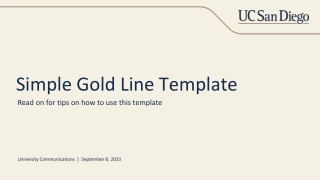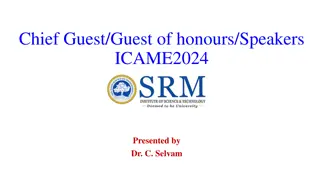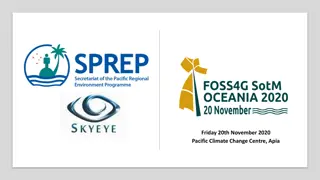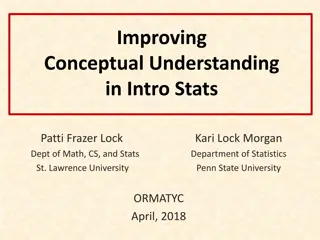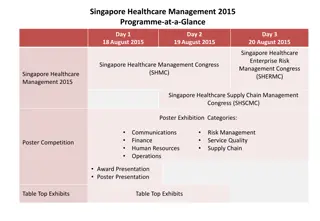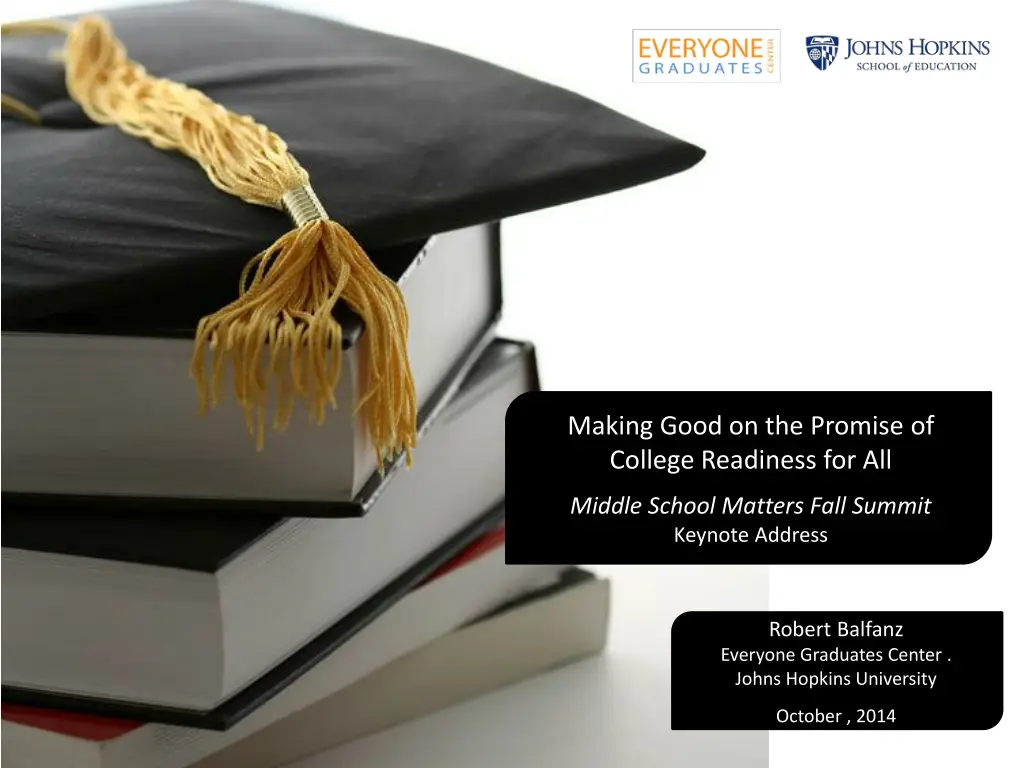
Understanding the Importance of College Readiness for All Students
Explore the critical need to ensure all students are college-ready and prepared for success in post-secondary education. Discover why our education system faces a new mission in the 21st century and the challenges schools and communities encounter in achieving this goal. Gain insights into the disparities between low-income and high-income students in graduation rates and post-secondary success, and uncover the key academic behaviors that contribute to students' success in higher education.
Download Presentation

Please find below an Image/Link to download the presentation.
The content on the website is provided AS IS for your information and personal use only. It may not be sold, licensed, or shared on other websites without obtaining consent from the author. If you encounter any issues during the download, it is possible that the publisher has removed the file from their server.
You are allowed to download the files provided on this website for personal or commercial use, subject to the condition that they are used lawfully. All files are the property of their respective owners.
The content on the website is provided AS IS for your information and personal use only. It may not be sold, licensed, or shared on other websites without obtaining consent from the author.
E N D
Presentation Transcript
Making Good on the Promise of College Readiness for All Middle School Matters Fall Summit Keynote Address Robert Balfanz Everyone Graduates Center . Johns Hopkins University October , 2014
WHY DO WE NEED TO MAKE GOOD ON THE PROMISE OF COLLEGE READINESS FOR ALL?
Our Public Education/High Education System Faces a New Mission for a New Century There is little work for young adults without a high school degree. And almost no work to support a family without some post- secondary schooling or training. As a result entire communities are being cut off from participation in American society and a shot at the American Dream. This weakens the nation at the very time the world is moving on US has fallen from 1st to 12th in college completion among young adults.
This Presents Our Schools and Communities With a Big Challenge Every student regardless of out-of-school needs, prior levels of school success, and current motivations needs to graduate from high school prepared to succeed in post-secondary school and training.
Understanding the Magnitude of our Challenge How many students in Texas do not graduate with their high school class?
Among Low Income Students what Percent Graduate from High School in 4 years? Of High School Completers Enroll in 2 or 4 year colleges? Graduate from 4 year institutions by age 25?
A Tale of Two Worlds Low Income High Income Graduate High School in Four Years Low 70 s Upper 80 s HS Completers Enroll in Two or Four 4 Year Institutions 51% 81% Graduate from Four Year Institution by Age 25 9% 54%
WHAT ARE THE ACADEMIC BEHAVIORS AND OUTCOMES 9TH GRADERS WITH A 75% CHANCE OF SUCCEEDING IN THE STATE UNIVERSITY SYSTEM HAVE?
5 Tools of Successful Students 1. High attendance 2. Did not get suspended 3. No course failures 4. B or better GPA 5. Mid-level or better test scores (They were also on-age for grade.)
In Short: They Are Good at School Only about 25% of 9th graders in most states achieve all these outcomes. When high-poverty students achieve these outcomes much of the poverty disadvantage to success in college goes away.
What Does This Tell Us? We have a clear goal to be on a strong path to college readiness students need to be good at school and have grade level skills by the end of 9th grade. Currently our school systems are not designed to achieve these outcomes. The Middle Grades are critical to our system re-design efforts.
On the Path to College Readiness for All We Have Academic Gaps Persistence Gaps Know-how Gaps Opportunity Gaps
THIS CONFERENCE COMBINES A FRAMEWORK TO UNDERSTAND THESE GAPS WITH ACADEMIC INTERVENTIONS AND STUDENT SUPPORT TOOLS TO COMBAT THEM STARTING IN THE MIDDLE GRADES
CRIS Framework: College Readiness is Multi-Dimensional and Needs to be Addressed at Multiple Levels Coursework, skills, and achievements needed to succeed at college-level work Beliefs, motivation, attitudes, and behaviors needed to successfully engage with academic challenges and college-going goals ACADEMIC PREPAREDNESS Knowledge, skills, and behaviors needed to access college and successfully navigate its demands COLLEGE KNOWLEDGE ACADEMIC TENACITY
Middle Grade Academic Gaps ACT finds that 8th grade test scores are more predictive of college success than high school scores. Chicago Consortium for School Research shows that as currently organized, middle grade schools do not alter the distribution of test scores very much come in low leave low. Bush Institute Middle Grades Matters shows in the last decade a significant body of effective evidence based practices and interventions has emerged in the areas of reading, writing, mathematics, and reasoning but they are not yet widely used.
Secondary Persistence Gaps Everyone Graduates Center, Chicago Consortium, and Gardner Center at Stanford show that attendance and course grades are the strongest predictors of both dropping out and college readiness. ACT Agrees. As a result, from early adolescents on, students are signaling early and often, that they are on and off track to high school graduation and college readiness. Early Warning Systems can help schools be aware of this and organize effective responses.
ABCs of Secondary School Success On Path to Dropping Out On Path to College Ready Early Indicator Miss 20 or more days- 10% Attendance Miss 5 or Fewer Have Self-Management, Regulation, and Advocacy Skills High on Hope Multiple Suspensions Sustained Mild Misbehavior Behavior F s and D s (Failure often driven by not completing/turning in assignments) Course Performance B average
Students who exhibit strong academic behaviors and get good grades are much more likely to succeed in high school and college. Predictors of High School Success Academic Behaviors Student Demographics 31% 31% School Factors EXPLORE Composite Score 9% 26% Middle School Grades 3% Academic behaviors important to student success Motivation Social Engagement Self-Regulation Enhancing College and Career Readiness and Success: The Role of Academic Behaviors
Know-How and Opportunity Gaps Among students who took the ACT 95% of Low Income Students said they wanted to attend post- secondary institutions but only 59% enrolled immediately. Among students who took the ACT only 69% of Low Income Students completed standard college prep sequence of courses in high school compared to 84% of High Income. Many college ready low income students do not apply to the most selective universities they qualify for, even though they are often better equipped to support them.
IS YOUR SCHOOL/DISTRICT ON-TRACK TO MAKING GOOD ON THE PROMISE OF COLLEGE READINESS FOR ALL?
Do You Know Your Challenge? What percent of 6th graders have below grade level skills in reading, writing, and mathematics and what is the magnitude? What percent of 6th graders have a prior history of chronic absenteeism? How many of your 8th graders have a GPA of 2.0 or below?
Do You Have the Data and Systems to Analyze and Use the Data to Keep Students On Track What data systems do you have to track students academic skills, attendance, behavior, and course performance? Do they provide an easy, integrated view? Are they user friendly? What procedures do you have in place to regularly analyze and act upon this data, to look for the most strategic level of intervention or prevention?
Sample Early Warning Indicator Classroom Level Data Display Off-Track Indicators and Assessment Data Behavior Comments Math Grades Literacy Grades Attendance Assessments Student 07-08: Days Absent 08-09: Days Absent Reading Grade Level Math PSSA 2008 Literacy PSSA 2008 07-08: Att.% 08-09: Att.% Dec Mar Dec Mar Dec Mar A 9 19 95% 84% 5 6 C D D C 8 Proficient Basic Below Basic B 12 13 93% 89% 7 8 D C F D 6.5 Basic Below Basic Below Basic C 48 69 73% 43% 10 10 F F F D 5.5
Do You Have Effective Prevention/Intervention Strategies at the Scale and Intensity Required? What preventions and interventions do you have in place to close academic skills gaps, promote good attendance, behavior, and course performance? Are they of sufficient capacity to meet the scale of your need? Do you have evidence that they are effective?
A Simple Grid for a Powerful Analysis Academic Interventions Behavior and Effort Course Performance Attendance Whole School Need: Capacity: Effectiveness: Targeted Intensive
Do You Have? A Multi-Dimensional and Multi-Level College Readiness framework in place, that organizes, integrates, and communicates your school or districts efforts.
Putting a Human Face on the Challenge http://www.pbs.org/wgbh/pages/frontline/education/dropout-nation/middle-school-moment/
OUR DESIGN BRIEF: POOL OUR KNOWLEDGE AND INSIGHTS TO CREATE PATHWAYS THAT PROPEL ALL STUDENTS FROM THE MIDDLE GRADES TO COLLEGE READINESS
For more information Visit the Everyone Graduates Center at www.every1graduates.org For this and additional PowerPoints presented during Middle School Matters, please visit www.every1graduates.org/bushinstitute2014

